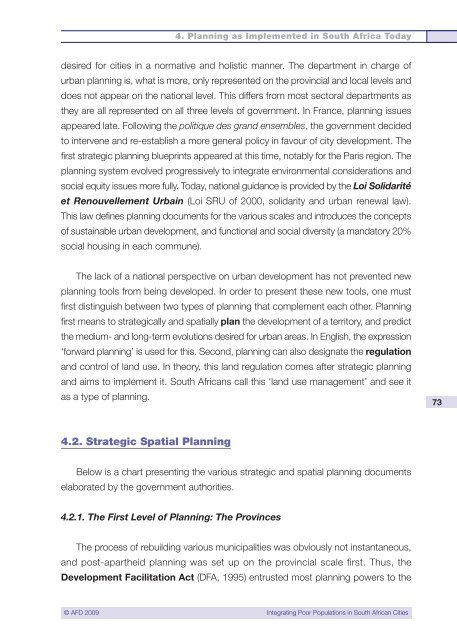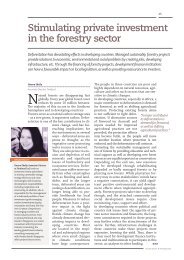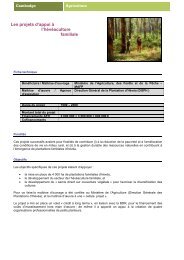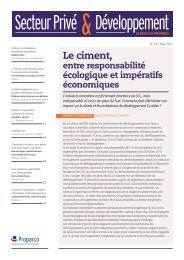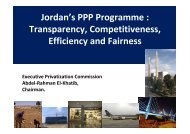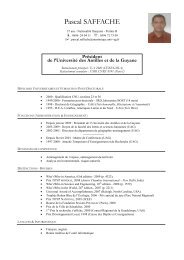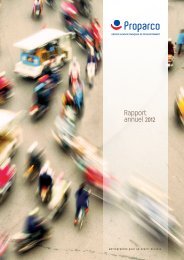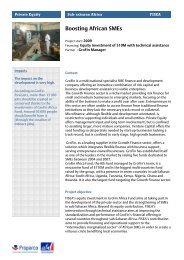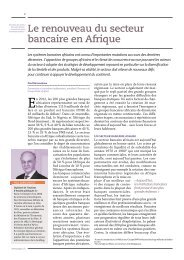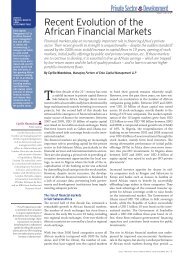Integrating Poor Populations in South African Cities - Agence ...
Integrating Poor Populations in South African Cities - Agence ...
Integrating Poor Populations in South African Cities - Agence ...
Create successful ePaper yourself
Turn your PDF publications into a flip-book with our unique Google optimized e-Paper software.
4. Plann<strong>in</strong>g as Implemented <strong>in</strong> <strong>South</strong> Africa Today<br />
desired for cities <strong>in</strong> a normative and holistic manner. The department <strong>in</strong> charge of<br />
urban plann<strong>in</strong>g is, what is more, only represented on the prov<strong>in</strong>cial and local levels and<br />
does not appear on the national level. This differs from most sectoral departments as<br />
they are all represented on all three levels of government. In France, plann<strong>in</strong>g issues<br />
appeared late. Follow<strong>in</strong>g the politique des grand ensembles, the government decided<br />
to <strong>in</strong>tervene and re-establish a more general policy <strong>in</strong> favour of city development. The<br />
first strategic plann<strong>in</strong>g bluepr<strong>in</strong>ts appeared at this time, notably for the Paris region. The<br />
plann<strong>in</strong>g system evolved progressively to <strong>in</strong>tegrate environmental considerations and<br />
social equity issues more fully. Today, national guidance is provided by the Loi Solidarité<br />
et Renouvellement Urba<strong>in</strong> (Loi SRU of 2000, solidarity and urban renewal law).<br />
This law def<strong>in</strong>es plann<strong>in</strong>g documents for the various scales and <strong>in</strong>troduces the concepts<br />
of susta<strong>in</strong>able urban development, and functional and social diversity (a mandatory 20%<br />
social hous<strong>in</strong>g <strong>in</strong> each commune).<br />
The lack of a national perspective on urban development has not prevented new<br />
plann<strong>in</strong>g tools from be<strong>in</strong>g developed. In order to present these new tools, one must<br />
first dist<strong>in</strong>guish between two types of plann<strong>in</strong>g that complement each other. Plann<strong>in</strong>g<br />
first means to strategically and spatially plan the development of a territory, and predict<br />
the medium- and long-term evolutions desired for urban areas. In English, the expression<br />
‘forward plann<strong>in</strong>g’ is used for this. Second, plann<strong>in</strong>g can also designate the regulation<br />
and control of land use. In theory, this land regulation comes after strategic plann<strong>in</strong>g<br />
and aims to implement it. <strong>South</strong> <strong>African</strong>s call this ‘land use management’ and see it<br />
as a type of plann<strong>in</strong>g.<br />
73<br />
4.2. Strategic Spatial Plann<strong>in</strong>g<br />
Below is a chart present<strong>in</strong>g the various strategic and spatial plann<strong>in</strong>g documents<br />
elaborated by the government authorities.<br />
4.2.1. The First Level of Plann<strong>in</strong>g: The Prov<strong>in</strong>ces<br />
The process of rebuild<strong>in</strong>g various municipalities was obviously not <strong>in</strong>stantaneous,<br />
and post-apartheid plann<strong>in</strong>g was set up on the prov<strong>in</strong>cial scale first. Thus, the<br />
Development Facilitation Act (DFA, 1995) entrusted most plann<strong>in</strong>g powers to the<br />
© AFD 2009 <strong>Integrat<strong>in</strong>g</strong> <strong>Poor</strong> <strong>Populations</strong> <strong>in</strong> <strong>South</strong> <strong>African</strong> <strong>Cities</strong>


